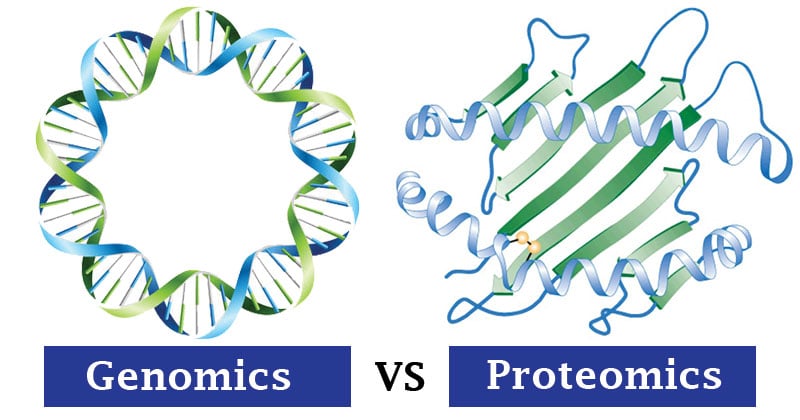
Interesting Science Videos
What are Genomics and Proteomics?
Genomics and proteomics are closely-related fields. The main difference between genomics and proteomics is that genomics is the study of the entire set of genes in the genome of a cell whereas proteomics is the study of the entire set of proteins produced by the cell.
10 Key Differences (Genomics vs. Proteomics)
| S.N. | Character | Genomics | Proteomics |
| 1. | Definition | Genomics is the study of genomes which refers to the complete set of genes or genetic material present in a cell or organism. | Proteomics is the branch of molecular biology that studies the set of proteins expressed by the genome of an organism. |
| 2. | Study of | Genomics is the study of the genes in an organism. | Proteomics is the study of all the proteins in a cell. |
| 3. | Unit under Study | The study of the function of genomes | The study of the function of proteomes |
| 4. | Nature of Study Material | The genome is constant. Every cell of an organism has the same set of genes. | The proteome is dynamic and varies. The set of proteins produced in different tissues varies according to the gene expression. |
| 5. | Use of High throughput techniques | High throughput techniques are used in the genomics to map, sequence, and analyze genomes. | In proteomics, characterization of the 3D structure and the function of proteins is carried out by the use of high throughput methods. |
| 6. | Techniques involved | The techniques involved in genomics include gene sequencing strategies such as directed gene sequencing, whole-genome shotgun sequencing, construction of expressed sequence tags (ESTs), identification of single nucleotide polymorphisms (SNPs), and the analysis and interpretation of sequenced data using different software and databases. | Techniques involved in proteomics include extraction and electrophoretic separation of proteins, digestion of proteins with the use of trypsin into small fragments, determination of the amino acid sequence by mass spectrometry, and identification of proteins using the information in the protein databases. Moreover, the 3D structure of the protein can be predicted using software-based methods. The expression of proteins can be studied by protein microarrays. Protein-network maps can be developed to determine protein-protein interactions. |
| 7. | Types | The two types of genomics are structural genomics and functional genomics. | The three types of proteomics are structural, functional, and expression proteomics. |
| 8. | Important Areas | Genome sequencing projects such as the Human Genome Project are the important areas of genomics. | Proteome database developments such as SWISS-2DPAGE and software development for computer-aided drug design are the important areas of proteomics. |
| 9. | Importance | Genomic studies are important to understand the structure, function, location, regulation of the genes of an organism. | The study of the entire set of proteins produced by a cell type is done in order to understand its structure and function. |
| 10. | Significance | Genes in the nucleus may not accurately portray conditions in the cell due to regulation at the RNA and protein level that can not be viewed in Genomics studies. | Proteomics studies are more beneficial because proteins are the functional molecules in cells and represent actual conditions. |
References
- Xiong J. (2006). Essential Bioinformatics. Texas A & M University. Cambridge University Press.
- Arthur M Lesk (2014). Introduction to bioinformatics. Oxford University Press. Oxford, United Kingdom
- http://www.dbriers.com/tutorials/2012/08/what-is-the-difference-between-genomics-vs-proteomics/
- http://jcb.rupress.org/content/216/1/21
- https://www.researchgate.net/post/What_Is_the_Difference_Between_Genomics_and_Proteomics
- http://pediaa.com/difference-between-genomics-and-proteomics/
- https://opentextbc.ca/biology/chapter/10-3-genomics-and-proteomics/
- https://courses.lumenlearning.com/boundless-biology/chapter/genomics-and-proteomics/
- https://www.scienceprofonline.com/genetics/difference-genome-proteome-metabolome.html
- https://www.differencebetween.com/difference-between-genomics-and-vs-proteomics/
- Snyder M. (2008). Introduction. The Yale Journal of Biology and Medicine, 80(4), 143–144.
- http://www.isaaa.org/resources/publications/pocketk/15/default.asp
